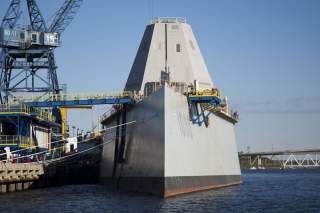The U.S. Navy Is Back: More Ships, More Technology (And More Firepower)
It is isn't all roses--but the American Navy is set for a strong increase in numbers.
Unless something changes — and let’s be clear, a lot of things could change — the U.S. Navy will finally achieve its goal of a substantially bigger fleet five years from now, in 2021.
That’s the year that, according to current planning, the U.S. fleet will grow to 308 frontline vessels, up from 278 in 2009. The fleet should number 287 “battle-force” warships — that is, ships with a combat mission — by the fall of 2016.
“With the strong support of Congress and close adherence to the long-range shipbuilding plan over the period 2009 to 2016, the Navy is certain to reach a battle force of 308 ships in 2021,” Sean Stackley, an assistant secretary of the Navy, and Vice Adm. Joseph Mulloy, a deputy chief of naval operations, explained in a written statement to the U.S. Senate in April.
It helps, of course, that the Navy has been buying large numbers of relatively small and inexpensive Littoral Combat Ships. In 2016, the Navy will possess 25 of the $500-million, 3,500-ton LCSs. Under current planning, that number swells to 34 LCSs by 2021.
The Navy recently decided to curtail the LCS program at 40 vessels — 12 hulls fewer than previously planned — and, at some point in late 2020s or early 2030s, acquire a new small surface combatant to complement the LCSs. The sailing branch is also adding more weaponry and sensors to a portion of the planned LCS force and redesignating these enhanced vessels as “frigates.”
But the fleet’s growth isn’t just an artifact of the LCS program’s high production rate of up to five ships per year. The Navy is also adding significant numbers of new destroyers and large amphibious ships.
The number of large surface combatants — destroyers and cruisers — in the U.S. fleet increases from 90 to 97 between 2016 and 2021 in the current shipbuilding plan.
The new combatants include all three Zumwalt-class stealth destroyers — each displacing a whopping 15,000 tons and costing around $4 billion. Lead shipZumwalt recently transferred to Navy ownership. She should become operational in 2016.
The Navy should also get six new Arleigh Burke-class destroyers. The $2-billion, 9,000-ton Burkes—arguably the best surface combatants the U.S. Navy has ever possessed — are set to remain in production for decades. A new version, the so-called “Flight III,” boasts more power-generation and a new, more-capable main sensor, the Air and Missile Defense Radar.
Meanwhile, the Navy wants to lay up two old Ticonderoga-class cruisers in 2020 and gradually update the 10,000-ton vessels, eventually returning them to the fleet to replace other Ticonderogas currently in service.
With their powerful radars and voluminous command centers, theTiconderogas are the Navy’s preferred platform for the “air-defense commander” role, overseeing the defensive operations of other missile-equipped warships. The Navy wants to maintain at least 11 Ticonderogas in service at any given time, in order to provide one cruiser to each aircraft carrier battle group.
But the Tico plan has proved controversial with the U.S. Congress, which has been keen to keep all the cruisers in continuous operation for as long as possible. It’s possible that lawmakers will intervene to alter the current cruiser-modernization scheme.
Amphibs account for much of the rest of the fleet’s expansion. In 2016, the Navy possesses 32 amphibious assault ships. That number increases by two by 2021, thanks to the completion of 25,000-ton San Antonio-class vessels, each costing $2 billion.
Responding to complaints from the U.S. Marine Corps about shipping shortfalls, Congress has strongly supported amphib-acquisition, even adding a 12th San Antonio to the construction plan, despite the Navy not requesting the vessel.
Generally speaking, the number of the vessels in the Navy’s various ship categories — small and large surface combatants, amphibious ships, aircraft carriers, etc. — is slowly ticking upward. But there’s one glaring exception to this trend. Attack submarines.
The Navy bought large numbers of attack subs in the 1980s but, in the 1990s, bought very few, creating a future “trough” in sub numbers as older boats decommission before new boats can enter the fleet.
Navy and Congressional leaders managed to increase sub-production to two per year for a combined $4 billion starting in 2012, but the boost came too late to arrest the undersea force’s mid-term decline. In 2016, the Navy possesses 52 nuclear-powered attack subs. That number remains essentially flat through 2020 before beginning a precipitous decline to a low of just 41 in 2029.
Despite this, the U.S. fleet is on track to continue growing. From 308 ships in 2021, the fleet should expand to 310 in 2022 and peak at around 313 vessels in 2025. “Shipbuilding must remain a top priority for the Department of the Navy if we are to continue to provide the measure of maritime security and power projection required of our naval forces in the decades ahead,” Stackley and Mulloy wrote.
This piece first appeared in WarIsBoring here.
Image: Creative Commons.

